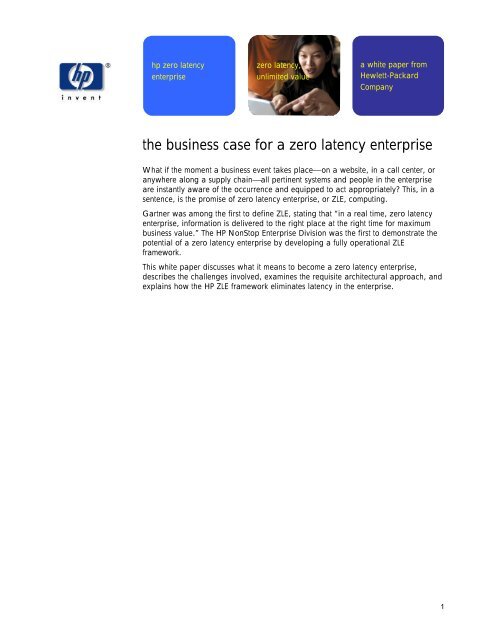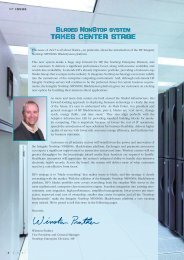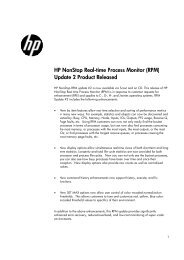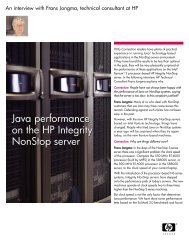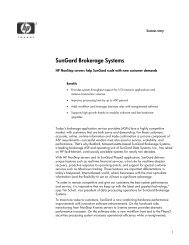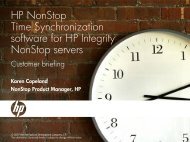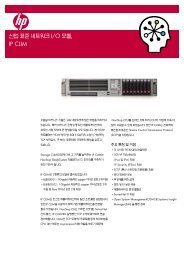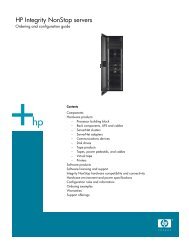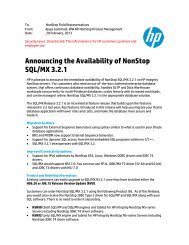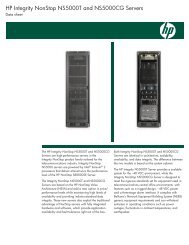the business case for a zero latency enterprise - HP NonStop
the business case for a zero latency enterprise - HP NonStop
the business case for a zero latency enterprise - HP NonStop
You also want an ePaper? Increase the reach of your titles
YUMPU automatically turns print PDFs into web optimized ePapers that Google loves.
hp <strong>zero</strong> <strong>latency</strong><strong>enterprise</strong><strong>zero</strong> <strong>latency</strong>,unlimited valuea white paper fromHewlett-PackardCompany<strong>the</strong> <strong>business</strong> <strong>case</strong> <strong>for</strong> a <strong>zero</strong> <strong>latency</strong> <strong>enterprise</strong>What if <strong>the</strong> moment a <strong>business</strong> event takes place⎯on a website, in a call center, oranywhere along a supply chain⎯all pertinent systems and people in <strong>the</strong> <strong>enterprise</strong>are instantly aware of <strong>the</strong> occurrence and equipped to act appropriately? This, in asentence, is <strong>the</strong> promise of <strong>zero</strong> <strong>latency</strong> <strong>enterprise</strong>, or ZLE, computing.Gartner was among <strong>the</strong> first to define ZLE, stating that “in a real time, <strong>zero</strong> <strong>latency</strong><strong>enterprise</strong>, in<strong>for</strong>mation is delivered to <strong>the</strong> right place at <strong>the</strong> right time <strong>for</strong> maximum<strong>business</strong> value.” The <strong>HP</strong> <strong>NonStop</strong> Enterprise Division was <strong>the</strong> first to demonstrate <strong>the</strong>potential of a <strong>zero</strong> <strong>latency</strong> <strong>enterprise</strong> by developing a fully operational ZLEframework.This white paper discusses what it means to become a <strong>zero</strong> <strong>latency</strong> <strong>enterprise</strong>,describes <strong>the</strong> challenges involved, examines <strong>the</strong> requisite architectural approach, andexplains how <strong>the</strong> <strong>HP</strong> ZLE framework eliminates <strong>latency</strong> in <strong>the</strong> <strong>enterprise</strong>.1
ecoming a <strong>zero</strong> <strong>latency</strong> <strong>enterprise</strong>The idea behind ZLE is simple⎯increase <strong>business</strong> responsiveness and competitivenessby eliminating <strong>latency</strong>, or “in<strong>for</strong>mation float,” from <strong>the</strong> IT systems supporting <strong>business</strong>functions. In a <strong>zero</strong> <strong>latency</strong> <strong>enterprise</strong>, whenever a <strong>business</strong> event occurs, itimmediately triggers appropriate responses and actions across <strong>the</strong> entire <strong>enterprise</strong>and beyond.The costs of <strong>enterprise</strong> <strong>latency</strong> are well known⎯frustrated customers, unin<strong>for</strong>meddecisions, low productivity, electronic fraud, and missed opportunities. ZLE technologyprovides a way to avoid <strong>the</strong>se and o<strong>the</strong>r <strong>business</strong> penalties by integrating, updating,and synchronizing data and applications in real time.value of real-time integrationCompanies in numerous industries⎯including financial services, telecommunications,manufacturing, and retailing⎯are starting to apply ZLE technologies to <strong>business</strong>processes such as customer relationship management (CRM), supply chainmanagement, <strong>business</strong> intelligence, and risk management. With real-time integrationof in<strong>for</strong>mation, <strong>the</strong>y gain consolidated up-to-<strong>the</strong>-second views of customers, orders, andproduct movements. Business processes accelerate. Customers enjoy more responsiveand more personalized service. Risk factors such as fraud and churn are exposed inreal time. And disparate systems and plat<strong>for</strong>ms⎯inside and outside <strong>the</strong><strong>enterprise</strong>⎯can share a common view.The ZLE environment also makes it possible to implement entirely new kinds ofapplications that depend on real-time integration. Companies can create new ways toleverage <strong>enterprise</strong> in<strong>for</strong>mation <strong>for</strong> increased efficiency and competitive advantage.ZLE requires a high-level architecture <strong>for</strong> real-time,<strong>enterprise</strong>wide consolidation of data and integrationof applications and processes.challenge of real-time integrationThe challenge of ZLE lies in its implementation. ZLE requires a high-level architecture<strong>for</strong> real-time, <strong>enterprise</strong>wide consolidation of data and integration of applications andprocesses. The demands placed on this architecture and its components aresubstantial.Enterprise <strong>latency</strong> results from stovepiped applications and islands of in<strong>for</strong>mation,inside and outside an <strong>enterprise</strong>. To route and synchronize in<strong>for</strong>mation across all of<strong>the</strong>m, companies need an extensible architecture that simultaneously• Integrates disparate data types into a consolidated real-time view• Supports transactional access <strong>for</strong> applications that require real-time data• Enhances <strong>business</strong> intelligence and analytic functionsfilling <strong>the</strong> functionality gapsThe ZLE architecture has to combine data and <strong>enterprise</strong> application integration (EAI),robust messaging, and a data warehouse or operational data store in a realtime−enabled infrastructure. Moreover, this infrastructure has to per<strong>for</strong>m tasks that gobeyond <strong>the</strong> traditional definitions of those components.2
EAI technologies have traditionally been limited in terms of scalability. Thus <strong>the</strong>y havebeen unable to handle <strong>the</strong> large event volumes that characterize a ZLE environment.EAI toolsets have also typically lacked <strong>the</strong> robust transactional and message storecapabilities required by a <strong>zero</strong> <strong>latency</strong> <strong>enterprise</strong>.Traditional data warehousing is normally implemented using high-<strong>latency</strong> (batch)extraction, trans<strong>for</strong>mation, and load (ETL) technology. Fur<strong>the</strong>rmore, it is focused onsummarizing historical data ra<strong>the</strong>r than providing real-time operational views. A datawarehouse is not typically equipped to handle high-volume data access and <strong>the</strong>concurrent mixed workloads (simultaneous real-time updates, time-critical transactions,and complex querying) that characterize a ZLE environment.The ZLE architecture has to fill those technology gaps by augmenting <strong>the</strong> applicationintegration capabilities of EAI with high-volume event capture, message trans<strong>for</strong>mationand routing, and <strong>business</strong> rules functionality. And it must enhance <strong>the</strong> data integrationstrengths of traditional data warehousing with real-time data caching, messagemanagement, and concurrent mixed-workload capabilities.providing a solid operational plat<strong>for</strong>mGoing beyond traditional EAI and database limitations is <strong>the</strong> functional challenge ofdeveloping a ZLE architecture. There is also <strong>the</strong> operational challenge of providing amassively scalable, 24 x 7 base <strong>for</strong> ZLE operations. ZLE is by nature operational.Once <strong>the</strong> architecture is implemented, with scores of systems depending on itsoperations, it is imperative that nothing halt or compromise <strong>the</strong> real-time flow oftransactions and messages⎯not even <strong>for</strong> a second.meeting <strong>the</strong> challenge: <strong>the</strong> hp ZLE frameworkThe <strong>HP</strong> ZLE framework (see figure 1) provides a unifying architecture <strong>for</strong> integrating,synchronizing, routing, caching, and per<strong>for</strong>ming transactions in real time. It eliminates<strong>enterprise</strong> <strong>latency</strong> and, at any given moment, provides a single, consolidated, and upto-<strong>the</strong>-secondview of all pertinent data from all <strong>the</strong> disparate applications it integrates.The <strong>HP</strong> ZLE framework provides a high-level architecture <strong>for</strong> existing systemenvironments and integrates with <strong>the</strong>m seamlessly and noninvasively. Enterpriseapplications such as CRM and <strong>enterprise</strong> resource planning (ERP) are attached to <strong>the</strong>ZLE framework with industry-standard EAI technologies, including application andtechnology adapters. Third-party EAI solutions from vendors such as SeeBeyond,TIBCO, and webMethods can also integrate with <strong>the</strong> ZLE framework. In<strong>for</strong>mation from<strong>the</strong>se applications and independent solutions is consolidated and cached at <strong>the</strong> logicalcenter of <strong>the</strong> framework—a virtual hub called <strong>the</strong> ZLE core.3
Figure 1. The ZLE framework.The ZLE core is a two-level construct that combines EAI and database technologies. Thecore’s services run on <strong>HP</strong> <strong>NonStop</strong> servers, which enable <strong>the</strong> ZLE framework’srequisite parallel per<strong>for</strong>mance, massive scalability, and continuous availability.Enterprise applications, however, are not <strong>the</strong> only applications that integrate with <strong>the</strong>ZLE core. Analytic applications can also integrate with <strong>the</strong> core and leverage <strong>the</strong>current-state data stored <strong>the</strong>re <strong>for</strong> operational analysis, <strong>business</strong> intelligence, and datamining purposes. Business rules generated using data mining tools can <strong>the</strong>n be loadedback into <strong>the</strong> ZLE core to be leveraged against new transactions or <strong>business</strong> events.Similarly, specialized ZLE applications can reside logically on top of <strong>the</strong> core and useits real-time services and data <strong>for</strong> such purposes as real-time personalization or frauddetection.Real-time in<strong>for</strong>mation from <strong>enterprise</strong> applications iscached in <strong>the</strong> ZLE data store <strong>for</strong> immediate access byo<strong>the</strong>r applications and <strong>the</strong>ir users.ZLE data store: added-value database functionalityThe foundation of <strong>the</strong> ZLE core is a new database construct called <strong>the</strong> ZLE data store(see figure 2). Real-time in<strong>for</strong>mation from <strong>enterprise</strong> applications is cached in <strong>the</strong> ZLEdata store <strong>for</strong> immediate access by o<strong>the</strong>r applications and <strong>the</strong>ir users. The in<strong>for</strong>mationis maintained and stored relationally. Accordingly, <strong>the</strong> ZLE data store functions as a• Hot <strong>enterprise</strong> cache⎯acts as a common database <strong>for</strong> <strong>enterprise</strong> applicationsattached to <strong>the</strong> ZLE core. Ra<strong>the</strong>r than integrating with one ano<strong>the</strong>r, applicationsintegrate directly with <strong>the</strong> ZLE data store, enabling <strong>the</strong>m to receive constantlyrefreshed in<strong>for</strong>mation in real time.• State engine⎯expresses <strong>the</strong> current <strong>business</strong> state of <strong>the</strong> <strong>enterprise</strong>, moment tomoment. Applications can draw on this current state in<strong>for</strong>mation to get consolidatedreal-time views of customers, processes, and so on.• Real-time data warehouse⎯supports end-user querying and provides a downstream<strong>enterprise</strong> data warehouse or data marts with real-time in<strong>for</strong>mation.• Relational message store⎯acts as a relational repository from which in<strong>for</strong>mation canbe reliably routed to subscriber systems via publish/subscribe messaging.4
Figure 2. The ZLE data store.enabling <strong>the</strong> ZLE data store: hp <strong>NonStop</strong> SQL databaseThe ZLE data store is based on <strong>the</strong> <strong>HP</strong> <strong>NonStop</strong> SQL database managementsystem, a cluster-aware database that handles <strong>the</strong> majority of <strong>the</strong> world’ssecurities, point of sale (POS), and ATM transactions and underpins many ofits largest <strong>business</strong> intelligence systems. Unique in its ability to handle largevolumes of concurrent mixed workloads, <strong>the</strong> <strong>NonStop</strong> SQL database isoptimized to handle massive database inserts, updates, and reads on a widevariety of priority levels simultaneously.The <strong>NonStop</strong> SQL database also leverages <strong>the</strong> parallel per<strong>for</strong>mance, faulttolerance, and linear scalability of <strong>NonStop</strong> servers; provides comprehensiveonline manageability features to minimize planned downtime; and possessesan integrated publish/subscribe capability <strong>for</strong> reliable, high-per<strong>for</strong>mancemessaging.ZLE core servicesIn addition to <strong>the</strong> ZLE data store, <strong>the</strong> ZLE core consists of an array of ZLE core services,including transactional and asynchronous (publish/subscribe) messaging services, ETL(batch) services, and event capture services. All are tightly integrated with <strong>the</strong> ZLE datastore and can leverage <strong>the</strong> parallel per<strong>for</strong>mance, scalability, and continuousavailability of <strong>the</strong> <strong>NonStop</strong> plat<strong>for</strong>m.5
For example, core transactional services run on top of a choice of industry-standardtransaction server environments, including J2EE-compliant <strong>HP</strong> <strong>NonStop</strong> EnterpriseApplication Server (EAS) software and CORBA or Tuxedo technology−basedtransaction monitors. They include a unified <strong>business</strong> rules service, a high-per<strong>for</strong>mancedata trans<strong>for</strong>mation service, and a sophisticated scoring service <strong>for</strong> personalization.Tasks per<strong>for</strong>med by <strong>the</strong>se services are run in parallel and are load balanceddynamically across <strong>NonStop</strong> server nodes.Industry-leading partners and <strong>HP</strong> itself supply <strong>the</strong> technology behind <strong>the</strong>se ZLE coreservices (see sidebar). Working side by side with <strong>the</strong> ZLE data store, <strong>the</strong>se services areat <strong>the</strong> heart of <strong>the</strong> ZLE framework.marshalling an industryThe ZLE framework comprises <strong>the</strong> world’s broadest selection of ZLE-enablingsoftware from leading independent software vendors (ISVs).• Actional⎯Actional Control Broker technology <strong>for</strong> integrating applicationsresiding on any plat<strong>for</strong>m into a ZLE solution• Acxiom⎯AbiliTec customer data integration software <strong>for</strong> consolidated360-degree views of individual customers across all <strong>business</strong> lines andchannels• HNC Software⎯Blaze Advisor <strong>business</strong> rules software <strong>for</strong> simplified, realtimecontrol over <strong>business</strong> processes• Mercator⎯advanced metadata-driven trans<strong>for</strong>mation technology, at <strong>the</strong>heart of <strong>the</strong> <strong>NonStop</strong> Data Trans<strong>for</strong>mation Engine service• MicroStrategy⎯<strong>business</strong> intelligence software and Narrowcast Networkstechnology• Protagona⎯high-per<strong>for</strong>mance database marketing solutions that leverage<strong>the</strong> ZLE framework• SAS⎯analytic and data mining solutions <strong>for</strong> turning raw data—including<strong>the</strong> real-time data in <strong>the</strong> ZLE data store—into usable knowledge• SeeBeyond⎯eBusiness Application Integration solutions <strong>for</strong> enabling <strong>the</strong>seamless flow of in<strong>for</strong>mation within and among <strong>enterprise</strong>s in real time• TIBCO⎯total <strong>business</strong> integration solutions <strong>for</strong> seamlessly integrating<strong>business</strong> systems in real time• Trillium⎯data quality software <strong>for</strong> cleansing, standardizing, and linkingdata based on <strong>business</strong> rules• webMethods⎯integration software <strong>for</strong> linking <strong>business</strong> processes,applications, databases, and workflows across and beyond <strong>enterprise</strong>sseizing <strong>the</strong> moment: ZLE in <strong>the</strong> real worldThe ZLE framework per<strong>for</strong>ms myriad <strong>business</strong> functions concurrently and in real time.Within a moment’s time, vast amounts of data are captured, trans<strong>for</strong>med, cleansed,integrated, hot-cached, and enriched. Thus <strong>the</strong> ZLE framework adds immeasurablevalue to <strong>the</strong> specialized ZLE applications it supports and all <strong>the</strong> <strong>enterprise</strong> applicationsthat it indirectly integrates.6
enabling ZLE applicationsZLE applications are new kinds of high-value applications that could not exist withoutaccess to <strong>the</strong> real-time data that flows through <strong>the</strong> ZLE framework and <strong>the</strong> services thatpopulate <strong>the</strong> ZLE core. At <strong>the</strong> same time, <strong>the</strong>y “customize” <strong>the</strong> ZLE core <strong>for</strong> specifictasks. The <strong>HP</strong> Interaction Manager, <strong>for</strong> example, captures customer interactionin<strong>for</strong>mation as it moves through <strong>the</strong> ZLE core, leverages <strong>the</strong> core’s rules and scoringservices and real-time caching capabilities, and delivers recommendations based oncurrent data to various customer touch points—all inside of a half a second.The <strong>HP</strong> Customer Manager verifies, de-duplicates, and cleanses customer-related datain real time to ensure that <strong>the</strong> most timely and accurate customer in<strong>for</strong>mation isavailable to all applications that need it. It can also enrich customer data by makingcalls to programs such as Acxiom AbiliTec to access additional customer in<strong>for</strong>mation.ZLE partner products can be integrated into <strong>the</strong> ZLE core as well so that <strong>the</strong>y canleverage its services <strong>for</strong> such purposes as real-time campaign management, real-timeauthorization of e-payments, and narrowcasting real-time in<strong>for</strong>mation out to a user’sworkstation.enriching <strong>enterprise</strong> applicationsEnterprise applications that are connected to <strong>the</strong> ZLE framework are uniquely enriched.To start, <strong>the</strong>y are synchronized in real time with o<strong>the</strong>r applications across and beyond<strong>the</strong> <strong>enterprise</strong>. Yet <strong>the</strong>y are not directly dependent on <strong>the</strong> per<strong>for</strong>mance and availabilityof any o<strong>the</strong>r application because <strong>the</strong> only direct integration and synchronization iswith <strong>the</strong> ZLE core and its cache of <strong>enterprise</strong> in<strong>for</strong>mation. Hence system A may godown, but system B can still access <strong>the</strong> in<strong>for</strong>mation it needs from <strong>the</strong> continuouslyavailable ZLE data store.Synchronization is enabled by adapters embedded directly into applications from suchcompanies as BroadVision, Baan, SAP, Siebel, and PeopleSoft, which allow highvolumes of messages to pass between <strong>the</strong>se applications and <strong>the</strong> ZLE core. Asmessages come into <strong>the</strong> ZLE framework, <strong>the</strong> data can be aggregated, cleansed, andcached. Messages can also be enriched by data already cached in <strong>the</strong> ZLE data storeand by <strong>the</strong> application of <strong>business</strong> rules resident in <strong>the</strong> core.Concurrent with <strong>the</strong>se activities, <strong>the</strong> perpetually updated data cached in <strong>the</strong> ZLE datastore can be profiled by <strong>the</strong> core’s <strong>HP</strong> Mining Integration Facility and delivered directlyto data mining and <strong>business</strong> intelligence tools from such companies as MicroStrategyand SAS. The models created by <strong>the</strong>se tools can <strong>the</strong>n be deployed back into <strong>the</strong> core<strong>for</strong> use by <strong>the</strong> <strong>business</strong> rules service and <strong>the</strong> scoring service, which scores customerinteractions while <strong>the</strong>y are taking place to drive personalized customer service.The ultimate payback comes with <strong>the</strong> delivery, in real time, of valuable knowledge tocustomer-facing applications and touch points such as websites, call centers, WAPdevices, and more.ZLE advantages of <strong>the</strong> hp <strong>NonStop</strong> plat<strong>for</strong>m• Highest availability plat<strong>for</strong>m⎯continuous uptime• Best linear scalability⎯grows cost-effectively• Best absolute scalability⎯grows quickly and massively• Only database system with ZLE concurrent mixed-workload capabilities• Seamless integration with ZLE middleware components• Lowest total cost of ownership⎯2002 Standish Group TCO study7
extending <strong>the</strong> real-time <strong>enterprise</strong>With <strong>the</strong> introduction of <strong>the</strong> next-generation S76 and S86 family of <strong>HP</strong> <strong>NonStop</strong>servers, ZLE customers can take advantage of significant technology advancementsand substantial increases in per<strong>for</strong>mance. These enhancements deliver new types ofZLE functionality, which enables companies to do new things in real time.Advances that are of particular value to ZLE implementations include• Enhanced Java per<strong>for</strong>mance⎯up to 200 percent increase <strong>for</strong> selected Javaapplications• Enhanced I/O capacity and overall processing per<strong>for</strong>mance⎯up to 86 percentincrease in processor per<strong>for</strong>mance over previous <strong>NonStop</strong> servers• Increased memory size⎯so that data can be analyzed even faster and withouthaving to retrieve it from disk• A complete package of integrated Web servicesmaking real time more realIn a ZLE context, <strong>the</strong> boost in per<strong>for</strong>mance <strong>for</strong> selected Java applications⎯as well as<strong>the</strong> boost in overall per<strong>for</strong>mance, memory, and I/O⎯enables high-value decisions tobe made earlier in a <strong>business</strong> process. For example, in telecommunications, as soon asa telephone call is completed, it becomes a call detail record (CDR) that can be storedand analyzed with o<strong>the</strong>r CDRs <strong>for</strong> a variety of <strong>business</strong> purposes.But what if you could derive <strong>business</strong> value from calls be<strong>for</strong>e <strong>the</strong>y become CDRs—while <strong>the</strong> call is still taking place? You could get a better handle on fraud. You couldmake more efficient use of resources. And you could better serve subscribers. Theenhanced per<strong>for</strong>mance of <strong>NonStop</strong> servers brings real time to <strong>the</strong> real world in myriadways, at no incremental cost.Java and web servicesZLE technology provides as many benefits beyond an <strong>enterprise</strong>’s walls as it doeswithin <strong>the</strong>m. Web services enable applications to be invoked in a standard fashion byo<strong>the</strong>r applications over <strong>the</strong> Internet and intranets. Standard XML and <strong>the</strong> Simple ObjectAccess Protocol (SOAP) are used to define <strong>the</strong> services you want to provide and to find<strong>the</strong> services you want to use.The latest <strong>NonStop</strong> servers integrate a complete contingent of Web and Java servicesthat make it possible to safely expose <strong>the</strong> full array of ZLE core services to tradingpartners, customers, and o<strong>the</strong>r entities over <strong>the</strong> Internet without custom coding. The ZLEdata store audits all records of messages and transactions that flow inside and outside<strong>the</strong> <strong>enterprise</strong>, while <strong>the</strong> loosely coupled integration of applicatons enabled by <strong>the</strong> ZLEframework serves to protect <strong>enterprise</strong> systems in a Web services environment.Just as important, a Web services−enabled Java or C/C++ based application runningon a <strong>NonStop</strong> server inherits all <strong>the</strong> reliability and scalability of <strong>the</strong> <strong>NonStop</strong>architecture. Hence <strong>the</strong> ZLE core can deliver services reliably, regardless of how manyconcurrent SOAP messages it has to handle from inside and outside <strong>the</strong> <strong>enterprise</strong>.not a moment to loseBusiness responsiveness is something that must be proved every moment of every day.The <strong>HP</strong> ZLE framework has <strong>the</strong> proven ability to create real-time <strong>enterprise</strong>s. In a telcoCRM environment, <strong>for</strong> example, this includes <strong>the</strong> ability to support 40,000 call center8
agents, move 1.2 billion messages per day in real time, and manage 100 billion rowsof call detail and o<strong>the</strong>r customer in<strong>for</strong>mation.In a major retail environment, it includes handling a rich mix of 1,000 POS events,300 e-store transactions, 300 gift registry transactions, 300 refund transactions, and300 call center transactions—all in <strong>the</strong> same second. This is on top of providing fraudalerts, campaign management capabilities, and data extracts <strong>for</strong> closed-loop datamining.In a large-scale transportation environment, <strong>the</strong> ZLE framework has <strong>the</strong> proven abilityto unfalteringly handle a challenging mixed workload while scaling linearly andabsolutely above <strong>enterprise</strong>-scale alternatives. It also provides a more rapid and costeffectivedevelopment solution than <strong>the</strong> competition.Embracing ZLE is not a question of “if” anymore. According to Gartner, “<strong>the</strong> sooner an<strong>enterprise</strong> embraces and implements <strong>the</strong> concept of <strong>zero</strong> <strong>latency</strong>, <strong>the</strong> stronger itscompetitive position is likely to be.” The ZLE framework stands alone in providing <strong>the</strong>blueprint, <strong>the</strong> architecture, <strong>the</strong> integrated <strong>HP</strong> and partner solutions, and <strong>the</strong> globalprofessional services to cut <strong>the</strong> costs and take <strong>the</strong> risks out of moving to <strong>zero</strong> <strong>latency</strong>.For more in<strong>for</strong>mation, go to www.hp.com/go/zle.May 2002. Java is a U.S. trademark of Sun Microsystems, Inc. Allo<strong>the</strong>r product names mentioned herein may be trademarks of <strong>the</strong>irrespective companies. <strong>HP</strong> shall not be liable <strong>for</strong> technical or editorialerrors or omissions contained herein. Nothing contained herein isintended or should be construed to be a warranty of this product or itsper<strong>for</strong>mance. All <strong>NonStop</strong> servers have specific warranty terms andconditions available to <strong>the</strong> customer <strong>for</strong> review. The in<strong>for</strong>mation in thisdocument is subject to change without notice.Printed in <strong>the</strong> U.S.A. 02-0419©2002 Hewlett-Packard Company9


